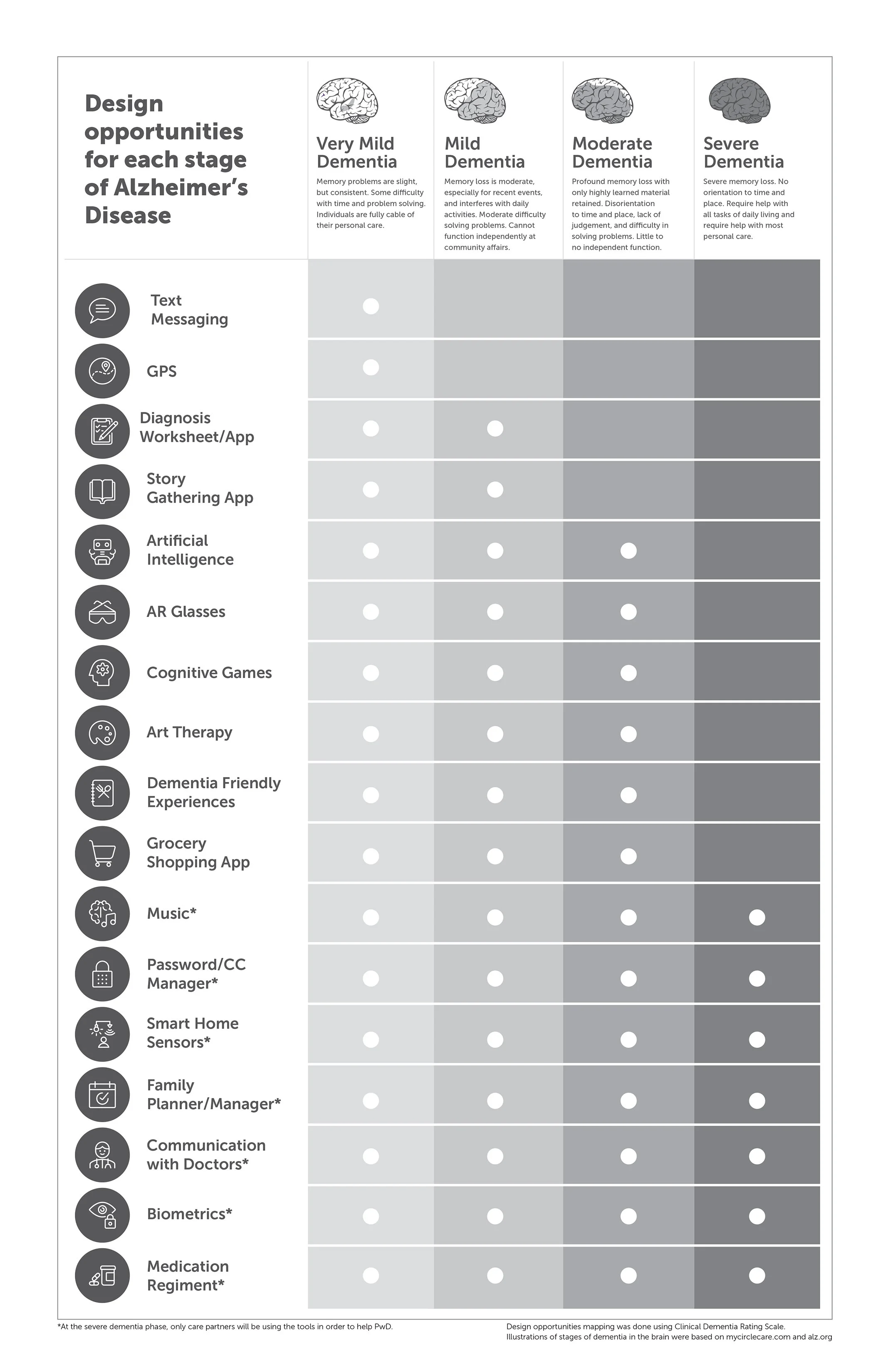A lack of knowledge may lead to fear of designing for people with dementia.
Research, Data Visualization
Group Project: Nichole Chaney, Tianran Chen, Akshat Srivastava, D.J. Trischler
InDesign and Figma
Inclusive Design
Design Challenge
Discovery- Choose a United Nations (UN) sustainable development goal / World Economic Forum (WEF) Strategic Initiative
Significance / The Problem- Research using primary and secondary sources to understand global issues, gain insights and find pain points
Use design methods to find emergent themes and solutions
Give an outline of design opportunities
Develop a prototype to pitch as a possible solution
Give insights and results of the project
Discovery
United Nations Sustainable Development Goal, No. 3
World Economic Form Strategic Initiative
Significance
For the first time in human history, more people are living over the age of 65 than children under the age of 5.
Longer life expectancies and aging baby boomers will increase the number of Americans who will be 85 and older (the oldest-old). Between 2012 and 2050, those who are 85 and older are expected to increase from 14% in 2012 to 22% in 2050, resulting in an additional 12 million oldest-old people — individuals at the highest risk for developing Alzheimer’s disease.
Current and Projected Global Population of 60+
Azheimer’s Association. 2019 Alzheimer’s Disease Facts and Figures. Alzheimers Dement 2019;15(3):321-87.
Problem
Global and National Dementia Cases
Awareness and empathy for people with dementia appear to be severely lacking among designers, leading to a scarcity of digital products and services accessible to and helpful for people with dementia (PwD) and their care partners.
Methods
Our team gathered 100 secondary sources and conducted 8 interviews with dementia experts such as: care partners, social workers, medical experts, and care managers.
Through primary and secondary research, we discovered the primary pain points for PwD and their caregivers .
Unleveraged design opportunities for PwD and their caregivers to assist with pain points
The researchers found that depending on the stage of dementia the PwD is in, there are many technologies, such as AI, VR, AR, biometrics, etc., that can be instrumental in assisting PwD and their care partners with their daily lives. These tools are currently not being leveraged to any significant degree. See graphic.
Concept sorting to find emergent themes
After gathering research, the team went through a series of concept sorting exercises where we observed patterns and sorted them into themes and opportunity areas.
The researchers narrowed down the themes even further– from five design opportunities to one solution.
Dementia Survey
The researchers sought to find out why designers were not designing for PwD, so we asked their opinions through an online survey. The survey, which received 55 responses, assessed if designers in the researchers’ networks are designing for PwD and why or why not.
The researchers hypothesized that knowing someone with dementia influences whether or not a designer considers PwD in their process.
The survey proved this theory wrong. The following diagram summarizes on the key findings from the survey that pertain to motivating factors for designers to consider PwD in their process.
Approximately 71% of designers said they would consider PwD in their design process if a client had interest or requirement in terms of accessibility.
Therefore, the researchers felt a strong inclination to focus their efforts in creating awareness and starting the conversation with CXO’s and business minded people.
The Prototype
There’s a plethora of opportunities to innovate or invent products that serve people with dementia. Having identified this gap, the researchers built a prototype that could start conversations with designers, create awareness and provide a creative tool to brainstorm.
Participatory design sessions were then conducted with three groups of three–four designers each to evaluate the efficacy of this generator as an innovation facilitation tool.
Screen-based prototype : Let’s Talk about Dementia!
The team used Apple’s Human Interface Guidelines to create an interface that was developed with PwD and their caregivers in mind, as an example for designers.
Simplicity:
High-contrast colors, large typeface, visible numbered steps, information button for additional instructions and a simple block/grid interface.
Perceptibility: Sound, video and readable content options to maximize understanding.
Results of Prototype Feedback
90% of the participants indicated they would find more information on dementia extremely valuable
54% were more familiar and excited to design for people with dementia after the workshop
Conclusion
Designers, developers, and entrepreneurs are often known and encouraged to step into unknown territories, but limited knowledge about the issue can instill a sense of fear and overwhelm in them.
Prototypes like the one the researchers used in the pilot workshop can help lighten the weight of a heavy topic like dementia. It then becomes less about coming up with the right answer or solution and more about broaching a difficult topic. While that may not lead to immediate solutions, the conversation can be a starting point of future invention or innovation processes.














